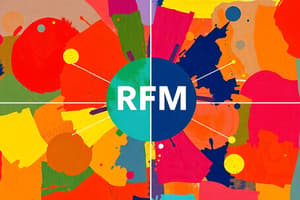Podcast
Questions and Answers
What does the rfm variable represent in the given code?
What does the rfm variable represent in the given code?
- A list of all customer IDs and their total purchases
- A DataFrame containing the recency, frequency, and monetary values for each customer (correct)
- A single value representing the total revenue of the company
- A function that calculates the RFM scores for each customer
What does the lambda function in the agg method do for the InvoiceDate column?
What does the lambda function in the agg method do for the InvoiceDate column?
- It filters out any duplicate invoice dates for each customer
- It converts the `InvoiceDate` column to a datetime format
- It calculates the number of days between the present date and the maximum invoice date for each customer (correct)
- It calculates the average invoice date for each customer
What is the purpose of the qcut function mentioned in the code?
What is the purpose of the qcut function mentioned in the code?
- It calculates the quartiles of the RFM values
- It performs a quartile normalization on the RFM values
- It converts the RFM values to quartile-based bins (correct)
- It removes any outliers from the RFM values
What does the rfm['recency'] = rfm['recency'].astype(int) line of code do?
What does the rfm['recency'] = rfm['recency'].astype(int) line of code do?
According to the given information, which customers are considered the top customers?
According to the given information, which customers are considered the top customers?
In the RFM model, which metric represents the frequency of a customer's purchases?
In the RFM model, which metric represents the frequency of a customer's purchases?
Which of the following is NOT a common type of customer segmentation?
Which of the following is NOT a common type of customer segmentation?
What does the 'RFM_Score' represent in the given RFM analysis?
What does the 'RFM_Score' represent in the given RFM analysis?
Which of the following is NOT a key benefit of customer segmentation?
Which of the following is NOT a key benefit of customer segmentation?
Which metric in the RFM model represents how recently a customer has made a purchase?
Which metric in the RFM model represents how recently a customer has made a purchase?
What is the main purpose of the qcut function mentioned in the code?
What is the main purpose of the qcut function mentioned in the code?
Which of the following is NOT a key component of the RFM model?
Which of the following is NOT a key component of the RFM model?
What is the purpose of the lambda function used in the agg method in the given code?
What is the purpose of the lambda function used in the agg method in the given code?
Which of the following is NOT a common way to segment customers using the RFM model?
Which of the following is NOT a common way to segment customers using the RFM model?
What is the main advantage of using the RFM model for customer segmentation?
What is the main advantage of using the RFM model for customer segmentation?
Flashcards are hidden until you start studying
Study Notes
Customer Segmentation
- Customer segmentation is a method of dividing customers into groups or clusters based on common characteristics.
- It can be done using various customer demographic characteristics, such as occupation, gender, age, location, and marital status.
- Psychographic characteristics, such as social class, lifestyle, and personality characteristics, and behavioral characteristics, such as spending, consumption habits, product/service usage, and previously purchased products, can also be used.
Need of Customer Segmentation
- It helps in identifying the most potential customers.
- It helps managers to easily communicate with a targeted group of the audience.
- It improves the quality of service and customer loyalty via a better understanding of segments.
- It helps managers to design special offers for targeted customers, to encourage them to buy more products.
- It also helps in identifying new products that customers could be interested in.
Types of Segmentation
- RFM (Recency, Frequency, Monetary) analysis is a behavior-based approach to grouping customers into segments.
- It groups customers based on their previous purchase transactions.
- It filters customers into various groups for the purpose of better service.
RFM Model
- Recency (R): Who has purchased recently? Number of days since last purchase (least recency).
- Frequency (F): Who has purchased frequently? It means the total number of purchases (high frequency).
- Monetary Value (M): Who has high purchase amount? It means the total money customer spent (high monetary value).
- Each of the three variables (Recency, Frequency, and Monetary) can be divided into four equal quartiles (Q1-Q4), which creates 64 different customer segments.
Steps of RFM
- Calculate the Recency, Frequency, Monetary values for each customer.
- Filter out top/best customers.
- Calculate the quartiles of RFM values using qcut() function.
RFM Implementation in Python
- Use pandas module to group customers by CustomerID.
- Calculate Recency, Frequency, and Monetary values using lambda functions.
- Change the column names.
- Calculate the quartiles of RFM values using qcut() function.
Assignment
- Find another data set with at least 50,000 records.
- Use the Lambda function for aggregation in the Pandas module.
- Perform RFM model on the new data set.
- Give examples of its use on the downloaded data set.
Studying That Suits You
Use AI to generate personalized quizzes and flashcards to suit your learning preferences.




